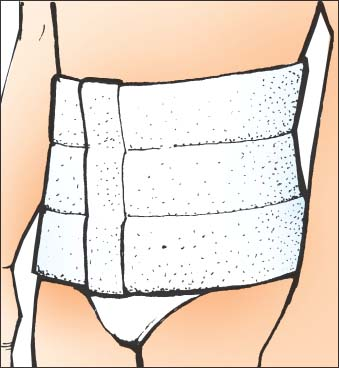Binder Application
Also known as self-closures, binders are lengths of cloth or elasticized material that encircle the chest, abdomen, or groin to provide support, keep dressings in place (especially for patients allergic to tape), and reduce edema, tension on wounds and suture lines, and breast engorgement in mothers who aren’t breast-feeding. Binders also promote patient comfort and the healing process. Typically, cloth binders are fastened with safety pins, and elasticized binders are fastened with Velcro.
Equipment
Tape measure ▪ binder of appropriate size and type ▪ safety pins ▪ gloves, if necessary ▪ dressing materials.
Commercial elastic binders are now commonly used instead of standard cotton straight and Scultetus binders that require pins. Disposable T-binders are available, and scrotal supports typically replace binders for male patients, except after abdominal-perineal resection.
Preparation of Equipment
Measure the area that the binder must fit, and obtain the proper size and type of binder from the central supply department.
Implementation
Check the doctor’s order.
Confirm the patient’s identity using at least two patient identifiers according to your facility’s policy.4
Provide privacy and explain the procedure to the patient.
Raise the patient’s bed to a comfortable working height to avoid muscle strain when applying the binder.
Position the patient in a supine position, with his head slightly elevated and his knees slightly flexed to decrease tension on the abdomen.
Assess the patient’s condition.
Remove the dressing and inspect the wound or suture line, if appropriate.
Redress the wound and then remove and discard your gloves.
Applying A Straight Abdominal Binder
Accordion-fold half of the binder, slip it under the patient, and pull it through from the other side. Make sure the binder is straight, free of wrinkles, and evenly distributed under the patient. Its lower edge should extend well below the hips.
Overlap one side snugly onto the other.
Starting at the lower edge, close the Velcro closure.
Make darts in the binder, as needed. Avoid making the binder too tight around the diaphragm because it may interfere with breathing. Then insert one finger under the binder’s edge to ensure a snug fit that’s still loose enough to avoid impaired circulation and patient discomfort.
For maximum support, wrap the binder so that it applies even pressure across the body section. Eliminate all wrinkles, and avoid placing pressure over bony prominences (as shown below).
 |
Applying A Breast Binder
Wash and thoroughly dry under pendulous breasts. Place 4″ × 4″ gauze pads under breasts, as necessary, to prevent skin irritation.
Slip the binder under the patient’s chest so that its lower edge aligns with the waist.
Straighten the binder to distribute it evenly on either side.
Place the binder so that the patient’s nipples are centered in the breast tissue. This position ensures proper breast alignment and support and produces faster tissue involution.
Stay updated, free articles. Join our Telegram channel

Full access? Get Clinical Tree


Get Clinical Tree app for offline access
